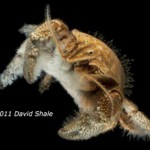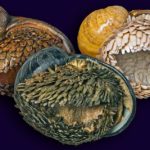Back in 2005, three researchers described and named a very unusual crab from a hydrothermal vent in the Indian Ocean (paper here). The scientists christened this crustacean Kiwa hirsuta from the name of the goddess of shellfish in Polynesian mythology and the Latin hirsutus meaning hairy. The later specifically referring some very hairy claws indeed.
Thus a legend was born, taming the media like no other. I’ll say it again. Everybody loves a fuzzy crab. I will note at the time, the Census of Marine Life did an excellent job with a public relations blitzkrieg and we all benefited from it.
In 2008 a team published that the dense hair like structures on the claws, legs, and stomach of the crab were covered with clusters of filamentous bacteria, making the crab appear extraordinarily ‘hairy’. More importantly those bacteria were determined to have key enzymes that allowed for chemosynthesis, i.e. the potential for carbon fixation and cycling of reduced and oxidized sulfur. But the purpose of Kiwa hirsuta housing bacterial groves on its exoskeleton was unclear.
Later that year, that hairy crab became the Yeti Crab and also became our number 12 best deep-sea species. And as Jarrett notes “I mean, how could you know love crabs from the Kiwa genus? They have fuzzy arms! And are adorable! People immediately began paying tribute with plush toys of all manner and even decorative food arrangements.”
Then in 2011 came a second species of Yeti Crab and the internet went buzz with a new dance sensation. Thurber et al. in PLoS One describe a new Kiwa a Costa Rican hydrothermal vent. The new species is christened Kiwa puravida, a conjunction of the Spanish words “pura” and “vida” meaning pure life, a common saying within Costa Rica. But the truly interesting finding is, as Ed Yong describes, “The bristles that cover the crab’s claws and body are coated in gardens of symbiotic bacteria, which derive energy from the inorganic gases of the seeps. The crab eats the bacteria, using comb-like mouthparts to harvest them from its bristles …Thurber thinks that K. puravida waves its claws to actively farm its bacterial gardens: movements stir up the water around the bacteria, ensuring that fresh supplies of oxygen and sulphide wash over them and helping them to grow. “This ‘dance’ is extraordinary and comical,” says Van Dover. “We’ve never seen this strategy before.”” Also see this write up at Thoughtomics.
And with that a new dance craze and internet meme began. Below is a roundup of videos (courtesy of Dr. Zen). Feel like something is missing? Well here are instructions to create your own. I will also note there is very disgraceful lack of hip-hop themed videos.







“I will also note there is very disgraceful lack of hip-hop themed videos.”
They’re coming at such a clip, one might be forgiven for missing one of the more recent one: http://www.youtube.com/watch?v=YuM5XNkadcA
That is much better
Well hey, a couple of weeks ago we found yet more yeti crabs out here at vents on the SW Indian Ridge, different in morphology to the Costa Rican seep and southern Pacific vent species (incidentally, K. hirsuta was described from the Pacific, rather than the Indian Ocean).
For a few first-glimpse photos, check out http://www.thesearethevoyages.net/jc67/diary.html
These boys don’t dance though, unlike the “puravida”s (which does sound a bit like a Ricky Martin song).